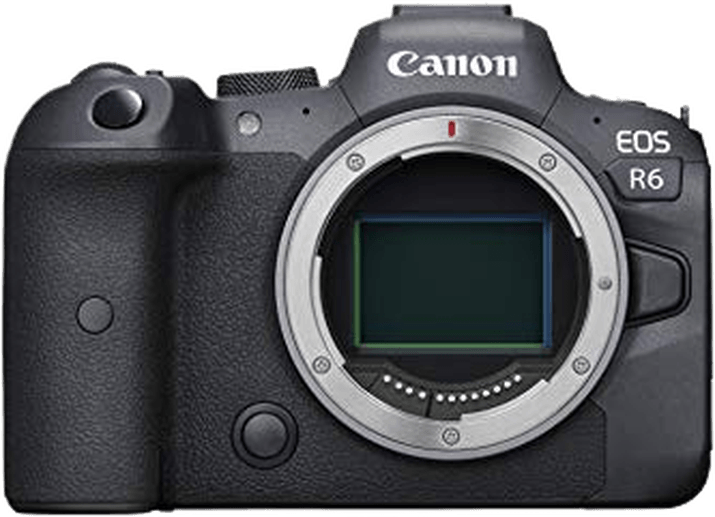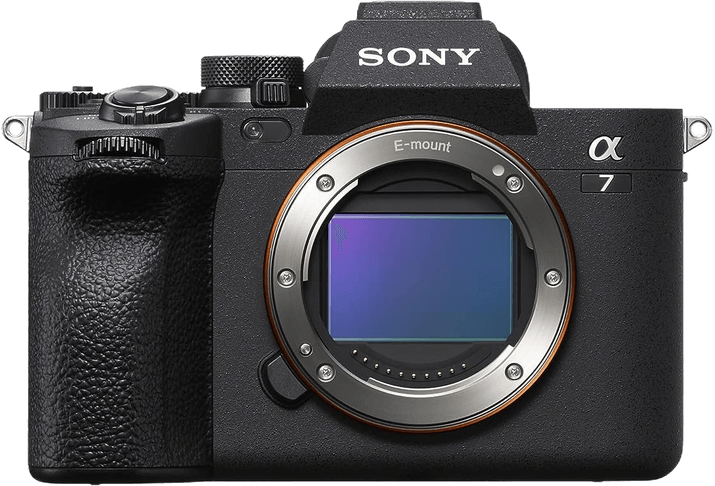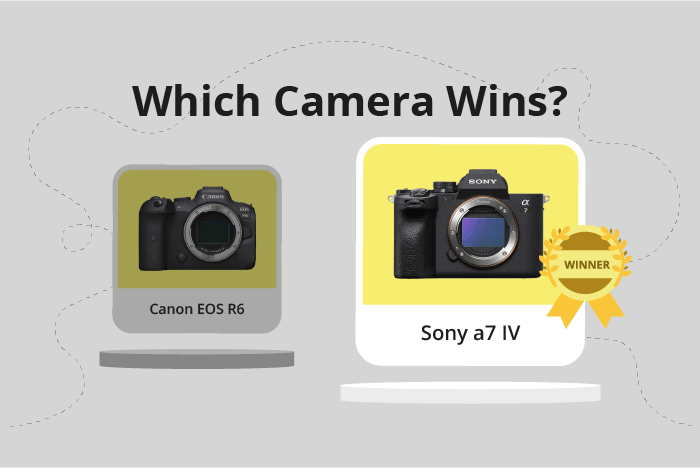Canon EOS R6 vs Sony a7 IV Comparison
Canon EOS R6

Sony a7 IV

The Sony a7 IV outperforms the Canon EOS R6, scoring 84/100 compared to the R6’s 80/100. Both mirrorless cameras share similarities in their launch price of $2499 and release years of 2020 and 2021, respectively.
The Sony a7 IV has an edge in compactness and lightweight design, measuring 131 x 96 x 80mm and weighing 659g. Meanwhile, the Canon EOS R6 is slightly larger and heavier, with dimensions of 138 x 98 x 88mm and a weight of 680g. This makes the Sony a7 IV more portable and user-friendly.
However, the Canon EOS R6 still holds its own with its robust construction and comfortable handling. It remains a solid choice for photographers who prioritize durability and ergonomics.
Ultimately, the Sony a7 IV is the winner due to its higher score, compact design, and lightweight build, while the Canon EOS R6 remains a strong contender for those who value sturdiness and handling.
Canon EOS R6 vs Sony a7 IV Overview and Optics
The Sony a7 IV wins in the optics department with a score of 85/100, compared to the Canon EOS R6’s score of 79/100. Both cameras share several specifications, including a CMOS sensor, full-frame sensor size, and image stabilization. Additionally, they both have unique lens mounts, with the Canon EOS R6 using the Canon RF mount and the Sony a7 IV using the Sony FE mount.
The Sony a7 IV outperforms the Canon EOS R6 in certain aspects. It has a higher megapixel count of 33 compared to the Canon’s 20.1, which allows for more detailed images. Moreover, the Sony a7 IV has a higher DXOMARK sensor score of 97, compared to the Canon’s 90, indicating better overall image quality. The Sony a7 IV also uses the Bionz XR processor, which contributes to its superior performance.
The Canon EOS R6 has its advantages as well. Its shooting speed of 20 frames per second is notably faster than the Sony a7 IV’s 10 frames per second. This makes the Canon EOS R6 more suitable for capturing fast-moving subjects or action photography. The Canon EOS R6 also uses the Digic X processor, which is a powerful processing unit in its own right.
Considering the optics of these cameras, the Sony a7 IV is the better choice for photographers who prioritize image quality and detail, while the Canon EOS R6 is more suitable for those who need faster shooting speeds. Both cameras offer excellent performance, and the choice ultimately depends on the specific requirements of the photographer.
Canon EOS R6 vs Sony a7 IV Video Performance
The Canon EOS R6 and Sony a7 IV are evenly matched when it comes to video capabilities, both scoring 91 out of 100. These cameras share several common specifications, making them competitive options for videographers.
Both the EOS R6 and a7 IV offer 4K video resolution with a maximum dimension of 3840 x 2160, ensuring high-quality footage across various shooting scenarios. Additionally, they both support a maximum video frame rate of 120fps, which is ideal for capturing smooth slow-motion footage. Furthermore, the time-lapse functionality built into both cameras enables users to create stunning time-lapse videos effortlessly.
Despite the tie in scores, there are certain aspects where one camera may excel over the other. For instance, the Canon EOS R6 might offer better color science, autofocus performance, or user interface, which could make it more appealing to some users. On the other hand, the Sony a7 IV could provide better low-light performance, dynamic range, or a more extensive selection of compatible lenses, making it a more attractive choice for others.
Ultimately, the decision between these two cameras will depend on the specific needs and preferences of the videographer. Both the Canon EOS R6 and Sony a7 IV are excellent choices for video work, offering high-quality 4K footage, fast frame rates, and time-lapse functionality. Users should carefully consider their requirements and evaluate the individual features of each camera to determine which one best suits their needs.
Canon EOS R6 vs Sony a7 IV Features and Benefits
The Canon EOS R6 wins the comparison with a feature score of 85/100, while the Sony a7 IV scores 83/100. Both cameras share several specifications, such as a 3-inch screen size, touchscreen functionality, flip screen, lack of GPS, and the presence of WIFI and Bluetooth connectivity.
The Canon EOS R6 outperforms the Sony a7 IV in screen resolution, with 1,620,000 dots compared to the Sony’s 1,040,000 dots. This higher resolution provides clearer and sharper image previews, making it easier for photographers to review their shots and make necessary adjustments. The two-point advantage in the feature score reflects this superior display quality on the Canon EOS R6.
The Sony a7 IV, however, does not have any significant advantages over the Canon EOS R6 in terms of features. Both cameras have the same core functionalities, making them suitable for various photography and videography needs. The slightly lower feature score of the Sony a7 IV is primarily due to its lower screen resolution.
Given the close scores and shared specifications, both the Canon EOS R6 and Sony a7 IV are excellent choices for photographers and videographers. The Canon EOS R6 has a slight edge in terms of display quality, but the Sony a7 IV remains a strong contender. Ultimately, the decision between these two cameras will depend on individual preferences and priorities.
Canon EOS R6 vs Sony a7 IV Storage and Battery
The Sony a7 IV wins in storage and battery with a score of 76/100, while the Canon EOS R6 scores 68/100. Both cameras have two memory card slots and support USB charging. The Sony a7 IV accepts CFexpress Type A and SD (UHS-II compatible) memory cards, while the Canon EOS R6 accepts SD, SDHC, and SDXC (UHS-II compatible) cards.
The Sony a7 IV outperforms the Canon EOS R6 in battery life, offering 580 shots compared to the R6’s 360 shots. The a7 IV uses the NP-FZ100 battery type, contributing to its longer battery life. The Canon EOS R6, however, uses the LP-E6NH battery type.
Despite the Canon EOS R6’s lower battery life, it supports a wider range of memory card types, providing more flexibility for photographers.
Considering these factors, the Sony a7 IV has a clear advantage in battery life, while the Canon EOS R6 offers greater compatibility with memory card formats.
Canon EOS R6 vs Sony a7 IV – Our Verdict
Are you still undecided about which camera is right for you? Have a look at these popular comparisons that feature the Canon EOS R6 or the Sony a7 IV:

